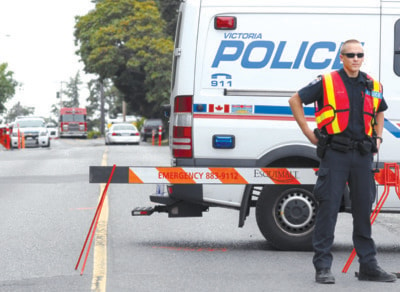VicPD finds increase again
Victoria City Council is curling its fingers around the newly approved 2013 city operating budget, and though increases will be stagnant for council wages, VicPD will be seeing yet another increase this term, despite the fact that the force remains the highest paid per capita in the province.
The Victoria Police Department requested a budget increase of 2.1 per cent, or $927,300 of a $43.7-million budget for 2013, which council gave preliminary approval to on Fri., March 8. VicPD says the proposed increase will largely go to cover rising wages as well as fund a new crime analyst position — with an expected salary and benefits of $85,000.
While the numbers are down from the 3.3-per cent increase VicPD saw in its 2011 budget ($41,599,869) to its 2012 budget ($42,958,468), a report by the Ministry of Public Safety and Solicitor General showed that, in 2010, VicPD’s cost per capita was $419 — the highest of all forces in the province. Vancouver PD came in second highest at $356.
“We are sticking to the guidelines of what the city laid out for us in this budget, and we are cognisant of the city’s restraint,” says Cst. Michael Russell, VicPD spokesperson. “Our goal is to still provide the best policing possible to serve the region, while targeting our crime-reduction strategy.”
Victoria will be expected to pay $784,700 (84.6 per cent) of the $927,300 increase, while Esquimalt is being asked to pay $142,600 (15.4 per cent). Esquimalt Mayor Barb Desjardins told media that her council has seen the numbers but hasn’t incorporated them into its overall municipal budget yet, noting it’s premature to say how Esquimalt will respond.
“If you look at the cost allocation to us based on the funding formula, it’s been increasing each year because our assessments have gone up and Victoria’s haven’t gone up as ours have,” Desjardins told media.
According to a 2012 report from VicPD, police budgets across the province increased by 55 per cent from 2002-2009, though VicPD increased by 46 per cent. The average increase in police strength from 2002-2009 was 18 per cent, while VicPD increased by 12 per cent. The last police union contract expired last year, but called for a salary increase of 1.3 per cent, effective Dec. 31, 2012. While the original estimate to cover the rising wages was $1.5 million, $318,200 in operating-cost savings were found through reducing the cost of overtime, travel, supplies and uniforms. The department has also decided not to have a backup radio system to CREST.
This is the first active year of Victoria City Council’s 2012 decision to hold tax increases to 3.25 per cent or below for 2013, 2014 and 2015. As of Friday, tactics for this year will include limiting mayoral and council salary increases to zero, changing council taxable remuneration, limiting non-unionized staff salary increases to zero as well as limiting the police budget increase to two per cent for 2013.
For the 2014 and 2015 budgets, council will be requesting that the Greater Victoria Library Board limit budget increases for Victoria’s contribution to the library system to two per cent for 2014 and 2015, and will request the Victoria Esquimalt Police Board to limit Victoria’s share of the police budget to two per cent for 2014 and 2015.
A grant for more homes
Speaking of budgets, the province announced this week that it will provide $400,000 in annual funding to the Greater Victoria Coalition to End Homelessness to help people find and maintain stable, affordable housing.
The funding will be used to provide rent supplements for up to 103 individuals each year through the Streets to Homes (S2H) Program, a strategy that works with people experiencing poverty, mental-health, and/or substance-use challenges to secure private market housing obtained through a comprehensive landlord support system. Now in its third year, S2H provides the rent subsidy as well as case planning and supports to help participants remain housed and become self-sufficient. The expanded support will be in place until April 1, 2015.
“The Streets to Homes program has proven to be an effective way to move people from homelessness into secure housing and end the cycle of homelessness,” says Rich Coleman, Minister of Energy, Mines and Natural Gas, and Minister Responsible for Housing. “We recognize how important it is to the community to continue this work.” M
